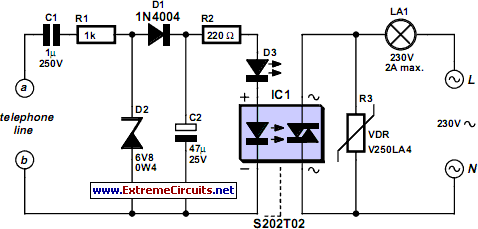Telephone Ringer
Circuit diagram:
Description
If you are lucky enough to have a big house, a large garden, and small children, this project just might interest you. It’s actually a telephone ringer capable of making any mains-powered device work from the ringer of your fixed line. With it, you will be able to control a high-powered siren or horn, as you like, in order to relay and amplify the low-level sound of your telephone (making it audible in a big house or in a large garden)! Alternatively, you can make a lamp light (or an indicator light) and so create a ‘silent ringer’ (helpful when small children are napping).
The other interesting part of this simple and inexpensive project is that it doesn’t require a power supply, contrary to similar items on sales in the shops. Before examining the drawing and understanding the principle involved, it is important to know that the ringer voltage on a fixed telephone line is pretty high. Since Europe and the EU Commission have not yet interfered, the exact value of this voltage and its frequency varies according to the country, but that’s not important here. The line carries direct current whether unoccupied or occupied.
Moreover, no more than a few hundred mAs needs to be stolen from an unoccupied telephone line to make the PSTN exchange believe the line is occupied. Therefore, capacitor C1 has the dual role of insulating this project with respect to direct current present on the line while unoccupied, or while occupied, while also allowing the ringer current to pass. The latter is rectified by D1 and clipped by D2 which makes about 6 V DC available to the C2 terminals when a ringer signal is present.
This voltage lights LED D3 which only serves as a visual indicator of proper operation as does the LED contained in IC1. This is a high-power photo triac with zero crossing detection from the mains, which allows it to switch the load it controls without generating even the lowest level of noise. This component, that we might just as well call a solid-state relay, was selected because it is comes in the form of a package similar to a TO220, a little bigger, and equipped with four pins. The pinout will not cause confusion because the symbols shown on our diagram are engraved or printed on the packaging. Since this circuit is not yet very common, we need to mention that it’s available from the Conrad Electronics website (www1.uk.conrad.com).
For the purpose of safe operation, the circuit is protected by a GeMOV on the mains side, called Varistor, VDR or SiOV depending on the manufacturer. The model indicated here is generally available. The load will be limited to 2 A, considering the model selected for IC1, which is more than sufficient for the application planned here. Finally, since a number of components in this circuit are connected directly to the mains power supply, the assembly should be placed in a completely insulated housing for obvious safety reasons.
circuit from http://www.extremecircuits.net/2010/05/telephone-ringer.html
